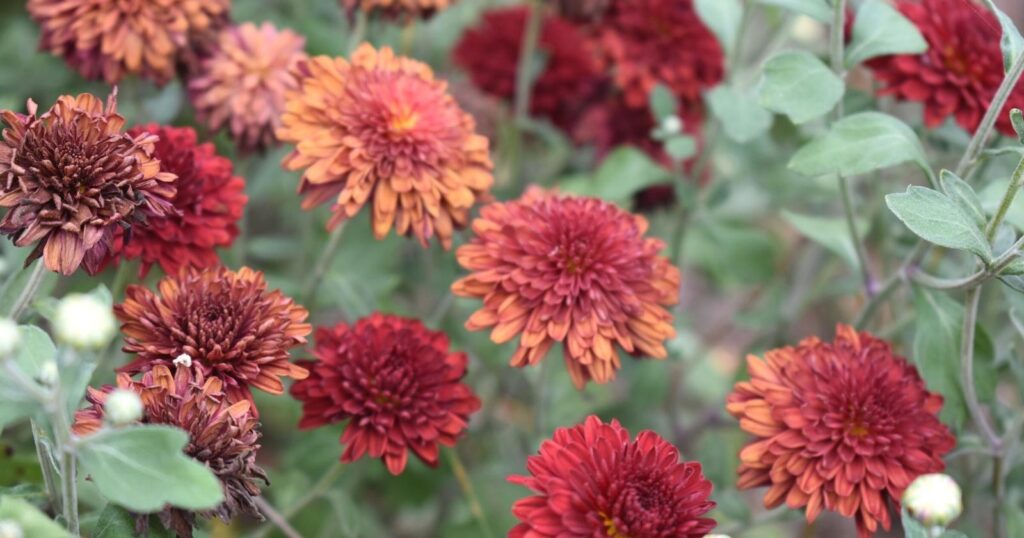Have you ever looked at your beautiful mums, only to notice they’re turning an unsightly shade of brown? It can be truly disheartening, especially when you’ve invested time and effort into nurturing these vibrant blooms.
The good news is, you’re not alone. Many plant lovers face this dilemma, and there are reasons behind it. Understanding why this happens is the first step to bringing your mums back to their lively, colorful selves. Stick with us as we delve into the possible causes and solutions, so you can restore your mums to their former glory and enjoy a garden that makes your neighbors green with envy.

Credit: www.reddit.com
Common Causes Of Browning Mums
Seeing your vibrant mums turn brown can be disheartening. Understanding the reasons behind this change is crucial to restoring their beauty. Several factors can contribute to the browning of mums, from environmental stress to pesky infestations. Whether you’re a gardening novice or a seasoned enthusiast, tackling these issues head-on can help you maintain your mums’ health and vitality.
Environmental Stress
Extreme weather conditions can wreak havoc on your mums. High temperatures or sudden frosts might cause the leaves to brown. If your mums are exposed to harsh sunlight, consider moving them to a shaded area. Conversely, if they’re suffering from frost, covering them with a protective cloth can help.
Watering Issues
Watering mums improperly can lead to browning. Too much water can suffocate the roots, while too little can dry them out. Ensure the soil is moist but not soggy. Water consistently, ideally in the early morning or late afternoon, to allow the roots to absorb the moisture effectively.
Pest Infestation
Pesky insects can be a nuisance for mums. Aphids, spider mites, and thrips can suck the life out of your plants, leaving them brown and wilted. Inspect your mums regularly for pests. Using insecticidal soap or neem oil can help manage these unwanted visitors without harming your plants.
Nutrient Deficiency
Just like us, mums need proper nutrition to thrive. A lack of essential nutrients like nitrogen or potassium can lead to browning leaves. Consider adding a balanced fertilizer to your soil. Regular feeding during the growing season can keep your mums looking lush and healthy.
Fungal Diseases
Fungi can be silent killers of your mums. Diseases like powdery mildew or leaf spot can cause browning. Ensure good air circulation around your plants to prevent fungal growth. If you notice signs of disease, using a fungicide can help protect your mums.
Have you faced any of these challenges with your mums? What strategies have you found effective in keeping your plants vibrant? Addressing these common issues with practical solutions can make all the difference in nurturing beautiful mums in your garden.

Credit: www.icangarden.com
Identifying Environmental Stress
Mums turning brown can be frustrating. Understanding environmental stress is crucial. Stress impacts their health and appearance. Identifying the causes helps in preventing browning.
Environmental factors play a big role. Temperature, sunlight, and soil conditions are key. Observing these can lead to healthier mums.
Temperature Fluctuations
Temperature changes affect mums. Extreme heat or cold can cause stress. Mums thrive in moderate climates. Sudden shifts harm their growth. Protect them from harsh weather. Use covers during extreme conditions.
Inadequate Sunlight
Sunlight is essential for mums. Lack of sunlight weakens them. Mums need at least six hours daily. Without it, they turn brown. Find a sunny spot for your mums. Avoid excessive shade.
Poor Soil Conditions
Soil quality impacts mums’ health. Poor soil leads to nutrient deficiency. Mums need well-draining soil. Compact soil restricts growth. Ensure soil is fertile and loose. Add compost for nutrients.
Proper Watering Techniques
Proper watering techniques are crucial for keeping your mums vibrant and healthy. If you’ve noticed your mums turning brown, the problem might stem from how you’re watering them. Getting the balance right can mean the difference between lush, colorful blooms and a garden full of wilted flowers. Let’s dive into the details of frequency, signs of overwatering, and signs of underwatering.
Frequency Of Watering
How often do you water your mums? This is a question that many gardeners face. Mums generally thrive when watered deeply but less frequently. Aim to water them once a week, ensuring the soil is moist but not soaked. If you live in a particularly hot or dry climate, you might need to water more often. Remember, it’s better to water deeply and allow the soil to dry slightly between sessions.
Signs Of Overwatering
Are your mums looking droopy despite getting plenty of water? Overwatering could be the culprit. Look for yellowing leaves and wilting stems—these are classic signs. You may also notice a foul smell from the soil, indicating root rot. Overwatering can suffocate your plants, so ensure your pots have good drainage and consider reducing the frequency of watering.
Signs Of Underwatering
On the flip side, underwatering can leave your mums looking parched and brown. Dry, crumbly soil is a clear indicator. If the leaves start to curl or become brittle, your plants are crying out for moisture. A quick test? Stick your finger into the soil; if it’s dry a couple of inches down, it’s time to give your mums a drink. Are your mums in pots? They may need more frequent watering than those planted in the ground.
Reflect on your watering habits: could adjusting them lead to healthier mums? Proper watering is a simple yet effective way to nurture your garden’s beauty. Stay observant and adjust as needed; your mums will thank you!
Dealing With Pests
Mums turning brown often signals pest issues. Pests like aphids or spider mites can damage the leaves. This leads to browning. Regularly checking plants and removing pests helps maintain healthy mums.
Dealing with pests can be a real challenge when you’re trying to keep your mums vibrant and healthy. One minute, your garden is a burst of color, and the next, those beautiful blooms are turning brown. I’ve been there, watching helplessly as my mums became a feast for unwanted guests. But don’t worry, you can reclaim your garden from these tiny invaders with the right strategies. Let’s dive into how you can tackle this issue effectively.Common Pests Affecting Mums
Mums are susceptible to a variety of pests that can cause them to turn brown. Aphids, spider mites, and thrips are the usual culprits. These pests suck the sap from the plant, leading to discolored and wilted leaves. Aphids are small, pear-shaped insects that gather on the undersides of leaves. Spider mites, although tiny, can cause significant damage, leaving the leaves speckled and discolored. Thrips are slender insects that leave silvery streaks on the leaves. Have you noticed any of these signs? Identifying the pest is the first step in addressing the problem.Natural Pest Control Methods
If you prefer a natural approach, there are several effective methods to consider. Introducing beneficial insects like ladybugs and lacewings can help keep pest populations in check. They feed on aphids and other harmful insects, acting as natural defenders for your mums. You can also make a simple soap spray by mixing a few drops of dish soap with water. This solution can suffocate soft-bodied insects like aphids and spider mites. Be sure to spray in the early morning or late afternoon to avoid damaging the plant. Neem oil is another excellent option. It disrupts the life cycle of pests, preventing them from reproducing. It’s both effective and environmentally friendly.Chemical Solutions
Sometimes, natural methods might not be enough, and that’s when chemical solutions come into play. Insecticidal soaps and horticultural oils are less toxic options that can effectively control pests without harming your mums. For more severe infestations, you might need to use stronger insecticides. Products containing pyrethrins or permethrin can be effective, but you must follow the instructions carefully to avoid harming beneficial insects. Before applying any chemical treatment, ask yourself if it’s truly necessary. Chemical solutions should be a last resort, used only when other methods fail. By taking these steps, you can protect your mums from pests and enjoy their vibrant colors throughout the season. What strategies will you try to keep your garden pest-free?Addressing Nutrient Deficiency
Brown mums often signal a nutrient deficiency in the soil. Essential nutrients like potassium and magnesium might be lacking. Addressing these deficiencies can revitalize your mums and restore their vibrant color. Regularly checking soil conditions and using balanced fertilizers helps maintain healthy plants.
If you’re wondering why your mums are turning brown, nutrient deficiency could be a key factor. Mums, like all plants, rely on a balanced diet to thrive. Missing out on essential nutrients can lead to brown, wilting leaves. Let’s dive into how you can address this issue effectively.Essential Nutrients For Mums
Mums need a variety of nutrients to grow healthy and vibrant. Nitrogen, phosphorus, and potassium are the primary ones. Nitrogen promotes lush, green growth; phosphorus strengthens the roots; and potassium enhances overall plant health. Besides these, calcium, magnesium, and sulfur also play supporting roles. Think of them as the vitamins and minerals that keep your mums in top shape.Fertilization Tips
Fertilizing your mums is crucial to combat nutrient deficiency. Opt for a balanced fertilizer, ideally a 10-10-10 mix, which provides equal parts of nitrogen, phosphorus, and potassium. Apply it according to the package instructions, typically every 4-6 weeks during the growing season. Over-fertilization can harm your mums, so moderation is key.Soil Amendments
Improving your soil can make a huge difference. Start by testing your soil’s pH and nutrient levels. A pH between 6.0 and 7.0 is ideal for mums. If your soil lacks nutrients, consider adding compost or well-rotted manure. These amendments enrich the soil, improving its structure and fertility. Is your soil too compacted or sandy? Add peat moss or perlite to enhance its texture. These tweaks can help ensure your mums get the nutrients they need. Have you ever tried these solutions? They might be the key to keeping your mums lush and vibrant all season long.
Credit: www.reddit.com
Managing Fungal Diseases
Mums turning brown often indicates fungal diseases. Poor drainage and overcrowded plants can worsen this issue. Keep plants dry and spaced for better air circulation to prevent fungal growth.
When your mums start turning brown, it can be disheartening, especially when you’ve put in effort to care for your garden. A common culprit is fungal diseases, which can rapidly turn vibrant blooms into a brown, mushy mess. Understanding how to manage these diseases can help you restore the health and beauty of your mums.Recognizing Symptoms
Fungal diseases often start with subtle signs. You might notice small brown spots on the leaves or stems, which eventually spread. If left unchecked, these spots can lead to wilting and browning of the entire plant. Another symptom could be a powdery coating on the leaves, a telltale sign of powdery mildew. By catching these symptoms early, you can stop the disease from spreading further.Preventive Measures
Prevention is your best defense against fungal diseases. Start by ensuring your mums have good air circulation, which reduces humidity around the plants. Space them out properly when planting. Watering is crucial too. Always water at the base of the plant, keeping the leaves dry to prevent fungal spores from thriving. Consider mulching around your mums to retain soil moisture and prevent splash-back from rain or watering.Treatment Options
If you spot signs of fungal disease, act quickly. Remove and dispose of any infected plant material to prevent further spread. You might be tempted to compost them, but this can spread the spores. Consider using a fungicide specifically designed for ornamental plants. Always follow the instructions carefully to avoid damaging your mums. Do you have a natural remedy you swear by? Some gardeners use a mixture of baking soda and water as a gentle treatment option. Managing fungal diseases in mums requires vigilance and timely action. With these strategies, you can keep your garden healthy and your mums blooming brightly. Have you ever faced this challenge in your garden? What methods worked for you?Tips For Healthy Mums
Mums turning brown can be frustrating. It often happens due to overwatering or poor sunlight. Ensure proper drainage and adequate light to keep mums vibrant.
Having healthy mums in your garden can be a source of pride and joy. Their vibrant colors and lush blooms brighten any space. However, maintaining their beauty requires some effort. If your mums are turning brown, don’t worry! With a few practical tips, you can keep them looking their best all season long.Regular Maintenance Practices
Regular maintenance is crucial to keep your mums healthy. Start by deadheading spent blooms. This encourages new growth and prevents the plant from wasting energy on seeds. Watering is another key aspect. Mums need consistent moisture but dislike being waterlogged. Check the soil regularly, and water when the top inch feels dry. Fertilizing your mums can boost their health. Use a balanced, slow-release fertilizer every 4-6 weeks during the growing season. This keeps the nutrients flowing and your mums thriving.Optimal Growing Conditions
Creating the right environment is essential for vibrant mums. Plant them in a location that gets at least six hours of sunlight daily. Too much shade can lead to leggy plants and fewer blooms. Ensure the soil is well-draining. Poor drainage can cause root rot, leading to browning leaves. Amend the soil with compost or sand if needed to enhance drainage. Spacing is another factor to consider. Give each plant enough room to grow without crowding. This allows air to circulate, reducing the risk of fungal diseases.Seasonal Care Advice
Adjusting your care routine as the seasons change can make a big difference. In spring, prune back any dead stems to encourage new growth. This sets the stage for a healthy start to the season. As summer heats up, check your mums more frequently for water needs. Mulching around the base can help retain moisture and regulate soil temperature. In the fall, consider protecting your mums from early frosts. Covering them with a light cloth on chilly nights can extend their blooming period. Have you ever noticed how a little extra attention can transform your garden? By applying these simple tips, you’ll see your mums flourish. What changes will you make to keep your mums healthy and vibrant?Frequently Asked Questions
What Causes Mums To Turn Brown?
Mums often turn brown due to overwatering, poor drainage, or exposure to frost. Check soil and weather conditions.
How Can I Prevent Mums Browning?
Ensure proper watering. Avoid overwatering. Use well-draining soil. Protect from frost with covers or mulch.
Can Sunlight Affect Mum’s Color?
Yes, mums need sunlight but not too much. Too much direct sunlight can cause browning. Provide partial shade.
Are Pests Responsible For Browning Mums?
Yes, pests like aphids can damage mums, causing browning. Inspect plants regularly. Use safe pest control methods.
Do Nutrient Deficiencies Cause Brown Mums?
Yes, lack of nutrients like phosphorus can lead to browning. Use balanced fertilizers to nourish your mums.
Conclusion
Caring for mums requires attention to detail. Brown leaves can signal trouble. Too much water, too little light, or pests might be the cause. Regular checks help keep them healthy. Adjust watering habits as needed. Ensure they receive enough sunlight daily.
Watch for pests and treat them promptly. Healthy mums bring joy and color to your space. Take these simple steps, and your mums will thrive. Remember, a little care goes a long way. With patience, you can enjoy vibrant, beautiful blooms.
Keep learning and observing. Your mums will thank you for it.




